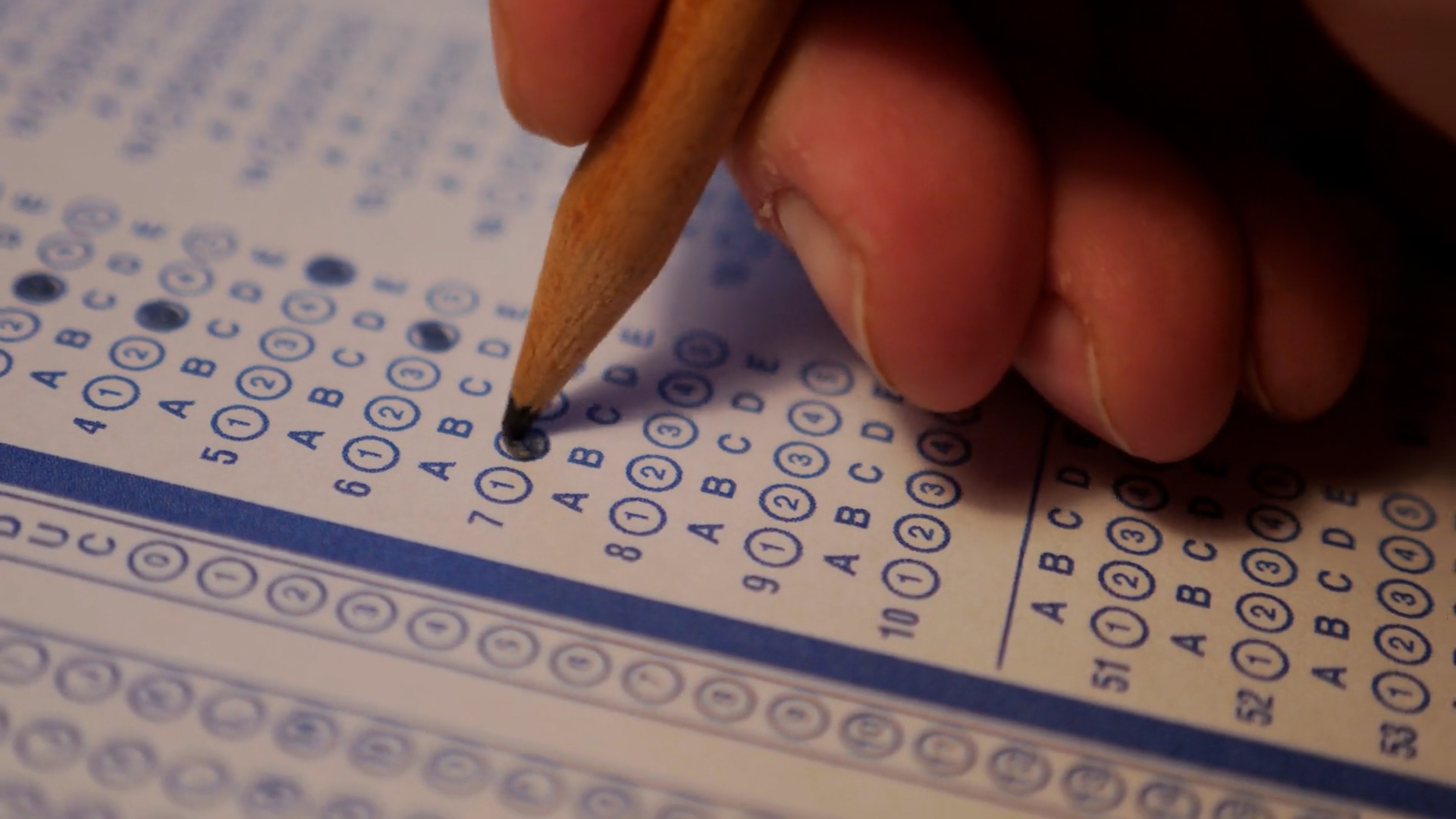What Is The STAAR Test, And Why Is So Much Riding On It?
The State of Texas Assessments of Academic Readiness, better known as the STAAR test, looms large over education in Texas. Kids skip school to escape it, teachers have to teach towards it, and politicians even tried to replace it. House Bill 4 was introduced this previous session and would have swapped the beleaguered test out for a new model that would provide smaller, more frequent tests with quicker feedback.
“HB 4 is not less accountability, it’s smarter accountability, providing actionable information for teachers, students and ultimately parents,” said Rep. Brad Buckley, the bill’s author.
HB4 even enjoyed rare bipartisan support before ultimately dying in the final weeks of the session.
But what is the STAAR test, and why does it dominate so much space in and out of the classroom? The answer delves into the history of Texas education, and its future.
A student fills in bubbles on a scantron.
The STAAR assesses students from third to twelfth grade on math, science, history, English, and a written essay. It’s not the first state assessment tool. Many tests have come before the STAAR to measure student performance, but the grading system has never had so much weight in school closures and state control.
The STAAR is also what determines schools’ accountability ratings.
Introduced by a 2017 law, the Texas Education Agency’s accountability ratings are the A-F scores each school receives every year.
70% of the rating accounts for students’ achievement on the STAAR and improvement from the year before. The other 30% is “closing the gaps,” or counting improvement from kids with special needs or English language learners. High schools are also graded based on graduation rates, and college, career and military readiness outcomes. Elementary and middle schools rely entirely on the STAAR.
These grades can determine whether or not schools stay open. If one school gets five “Fs” in a row, the whole district is vulnerable to a TEA takeover, like what happened in Houston ISD. In 2023 Phillis Wheatley High School prompted a TEA takeover for the entire Houston district, which has 274 schools. Locally elected trustees were replaced by a board and a superintendent hand-picked by Mike Morath, the TEA commissioner. Even though recent test results haven’t shown a vast improvement in test scores for those struggling campuses, the TEA said in June that it would maintain control of the district for at least two more years.
But tests were disrupted starting in 2020 with the onset of the Covid-19 pandemic. For two years after that, schools that scored below a C were left unrated.
2023 saw new upheaval when it came to STAAR testing. That year, the TEA changed the STAAR’s grading metrics and redesigned the test. More than 100 school districts sued the TEA to block the release of those scores. Those were held until earlier this year, when a judge ruled that Commissioner Morath was within his mandate to change the test.
Once released, those scores showed a spike in ‘F’ ratings. In 2019, a little over 5% of elementary schools received “Fs” or “Ds,” but this number shot up to almost 44% in 2023. Out of 77 elementary schools graded in 2023, 19 were given “Fs”. Out of the 112 schools graded in AISD, 30 got “Fs,” more than any other letter grade. Many educators think this is due to the STAAR redesign and TEA’s changing standards without enough time to prepare students and teachers.
But Commissioner Morath says it’s not the testing standards, but the schools that are the issue.
“If we’re talking about an elementary school and a middle school, which is the conversation we’re focused on in Austin, there’s no truth to that. The standards didn’t change,” Morath says. “These campuses that we’re talking about in Austin, I think the last time they met minimum academic standards was something like 2017, 2016. It’s been a long time since there were kids that were at those schools that could reach any reasonable level of proficiency.”
TEA commissioner Mike Morath.
The standards may not have changed but the structure of the test has. A 2021 law required that by 2023, the STAAR be administered entirely online. There are also more open-ended questions, or ‘constructed response items.’ For high schools, more students had to meet college and career benchmarks, or indicate they were joining the military in order for the campus to get a good grade. But these changes came late in the year, and many school districts argued that they hadn’t been given enough time to prepare for the new model. This led to the lawsuit that held up the 2023 results in court until this April.
2024’s scores have also been held up in court. Schools sued over TEA’s new “hybrid scoring” system. Those open-ended responses now go through an auto scoring engine, similar to Chat GPT, and a quarter of these answers then go to human scorers. TEA saved $15 million on human graders. Schools can pay extra to have tests re-evaluated by human scorers, which is what Dallas ISD did. They paid $232,000 to have their tests reviewed by people, according to the Dallas Morning News. More than 700 DISD scores improved.
But on average, AISD schools’ grades dropped five points since 2019. Many schools that received “Fs” in 2023 previously had a good track record. Wooldridge Elementary went from a “B” in 2019 to an “F” in 2023.
A breakdown of the data also shows a socioeconomic division between passing and failing schools. In Austin ISD, schools that reported more than half of their students as economically disadvantaged received a median score of 64, a D. Schools that reported less than half had a median score of 90, an A. At Dobie Middle School, the student body is over 96% economically disadvantaged, and almost three-quarters of the kids are learning English as a second language. The STAAR is offered in English after 5th grade, unless a student is newly arrived to the district.
“We’ve got kids that don’t speak the language, that haven’t been in school, and they went from getting one right to getting two right, that’s 100% growth,” says Chadwick Holloway, the former assistant principal at Dobie Middle School. “But it don’t matter cause it’s not enough.”
One school improved more than any other. Mendez Middle School was taken over by a charter in 2022 after years of struggle, and since then, their scores have improved. From 2019 to 2023, their score jumped 39 points, more than any other school. They went from an “F” to a “B.” But many parents at Mendez don’t like this change because they feel the administration excludes them from their kids’ education. Theirs is a potential future that awaits Dobie.
The 2023 STAAR test scores gave Dobie three ‘F’s in a row. While the 2024 results were tied up in another lawsuit, AISD officials feared it would be another ‘F’, putting the district uncomfortably close to a potential TEA takeover. To avoid this, AISD has opted for a district-managed restart of the campus. Under the restart plan, all the administration and most of the core subject teachers are no longer at Dobie. If scores don’t improve by the fall, a charter school will take the campus over in the fall of 2026, much like Mendez. The tumultuous spring semester left many parents, teachers and staff asking what the point of the STAAR test was.
“What’s the end game? What’s the goal?” says Holloway. “If you [TEA] wanna take over AISD, yeah, it measures exactly what it needs to measure. If you want to see disparities, it measures exactly what it needs to measure. But it's not a good tool for teacher effectiveness. It’s not a good tool for how quality a school is.”
And in Rundberg, the school is more than a learning hub. They house adult learning programs like HVAC certifications, host community meetings, food and blood drives, volunteering events, and so much more. But this community hub will be unrecognizable because of the amount of weight put on a test, taken by 11-14 year-olds.
Community journalism doesn’t happen without community support.
Got story ideas, advice on how we can improve our reporting or just want to know more about what we do? Reach out to us at news@klru.org.
And if you value this type of reporting, then please consider making a donation to Austin PBS. Your gift makes the quality journalism done by the Decibel team possible. Thank you for your contribution.
More in Education:
See all Education posts







Contact Us
Email us at news@klru.org